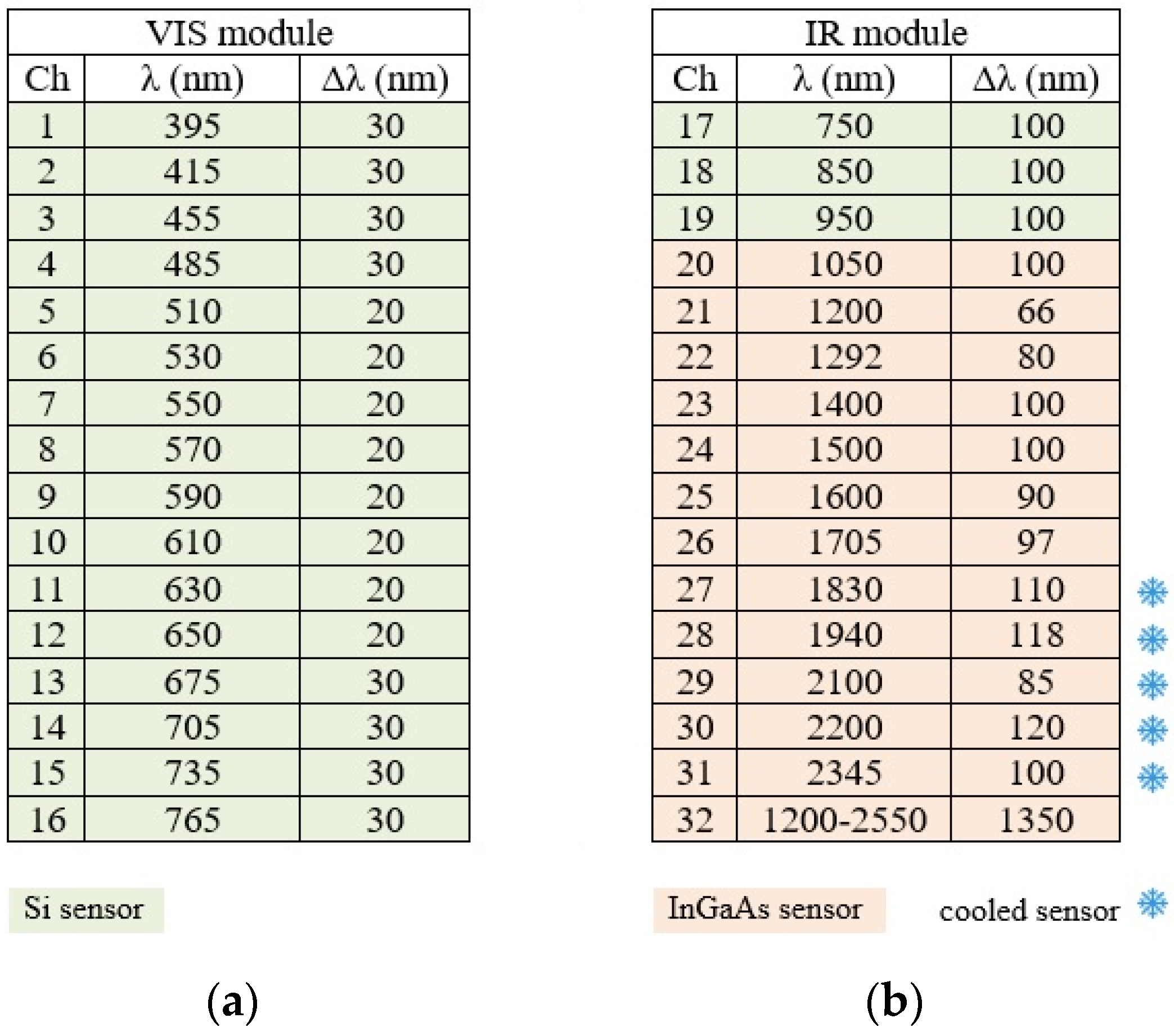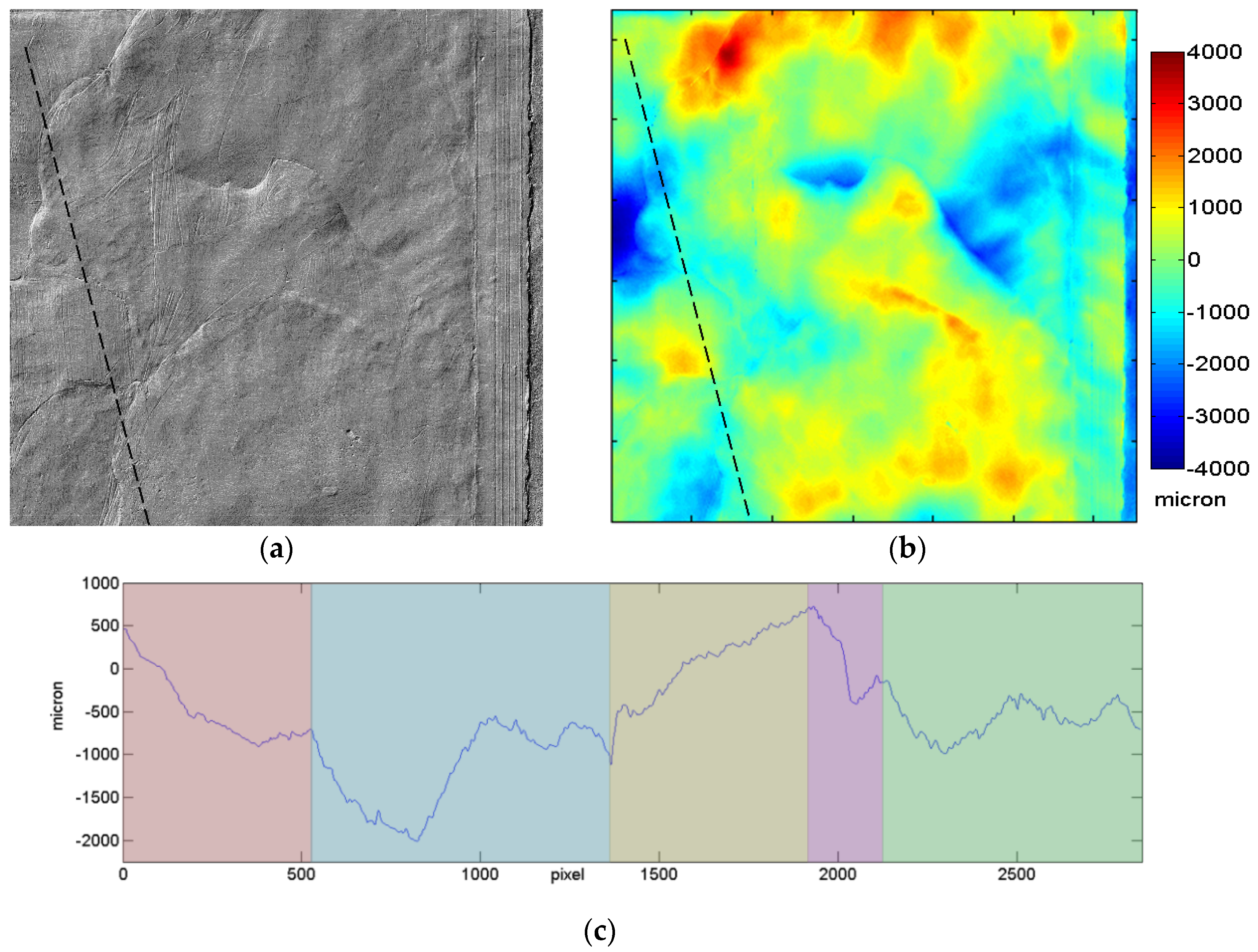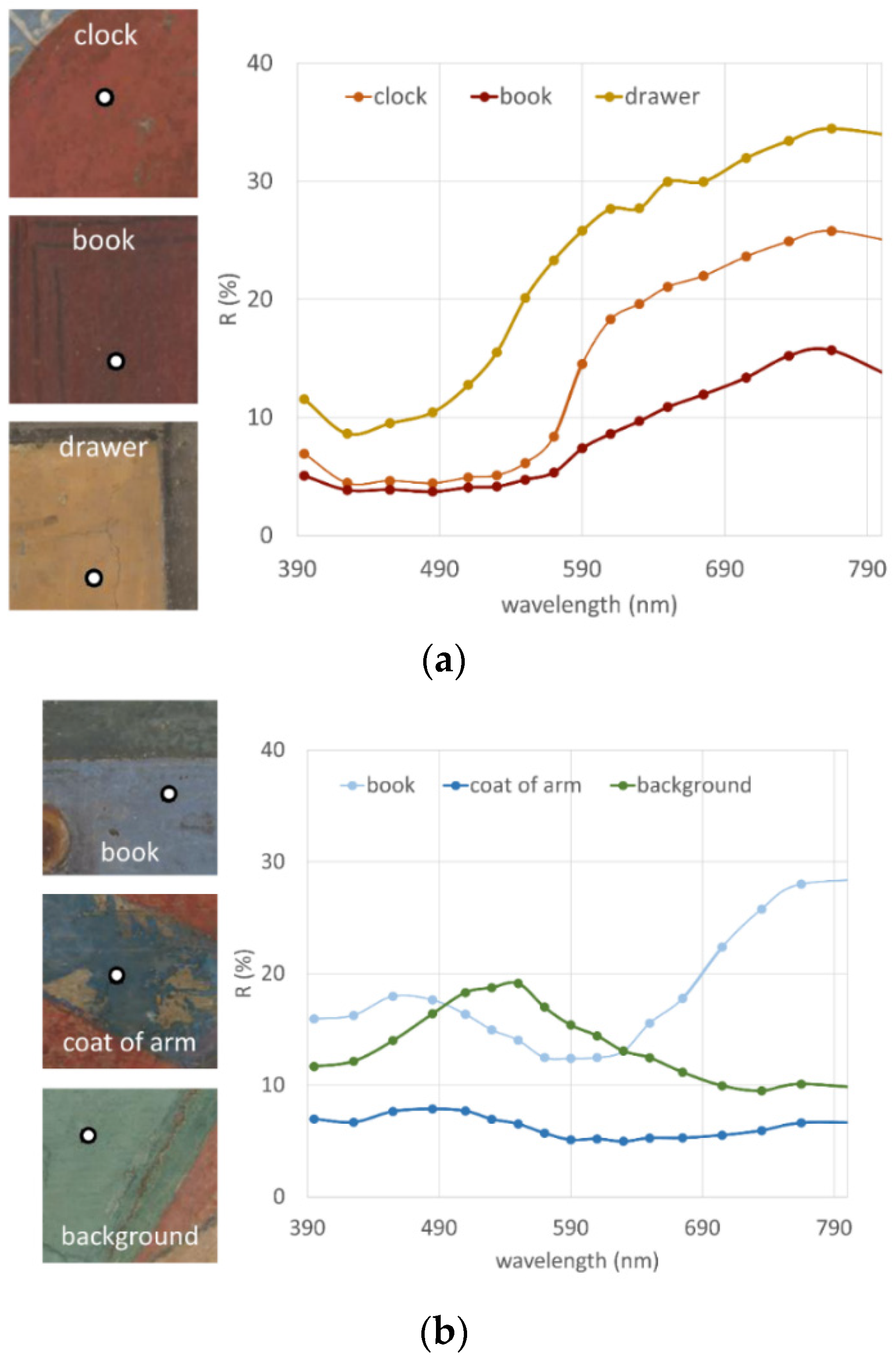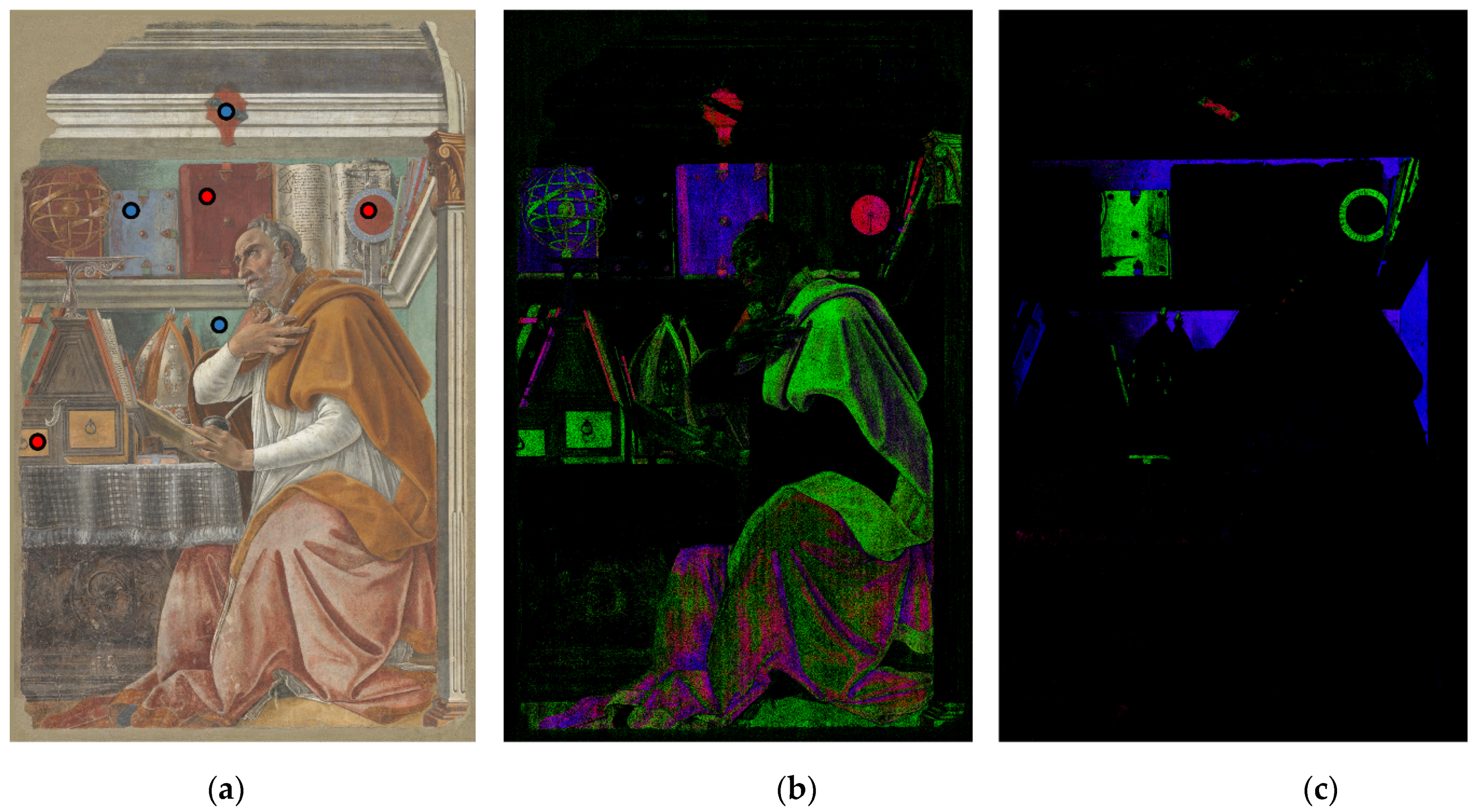Synchronized Hardware-Registered VIS-NIR Imaging Spectroscopy and 3D Sensing on a Fresco by Botticelli
Abstract
:1. Introduction
2. Materials and Methods
2.1. VIS-NIR Multispectral Scanner
2.2. Examined Artwork
3. Discussion and Results
4. Conclusions
Author Contributions
Funding
Institutional Review Board Statement
Informed Consent Statement
Data Availability Statement
Acknowledgments
Conflicts of Interest
References
- van Asperen de Boer, J.R. Infrared Reflectography: A Method for the Examination of Paintings. Appl. Opt. 1968, 7, 1711–1714. [Google Scholar] [CrossRef] [PubMed]
- Goetz, F.H.; Vane, G.; Solomon, B.N.; Rock, N. Imaging Spectrometry for Earth Remote Sensing. Science 1985, 228, 1147–1152. [Google Scholar] [CrossRef] [PubMed]
- Fischer, C.; Kakoulli, I. Multispectral and hyperspectral imaging technologies in conservation: Current research and potential applications. Rev. Conserv. 2006, 7, 3–16. [Google Scholar] [CrossRef]
- Karagiannis, G.; Salpistis, C.; Sergiadis, G.; Chryssoulakis, I. Non-destructive multispectral reflectoscopy between 800 and 1900 nm: An instrument for the investigation of the stratigraphy in paintings. Rev. Sci. Instrum. 2007, 78, 06511. [Google Scholar]
- Liang, H. Advances in multispectral and hyperspectral imaging for archaeology and art conservation. Appl. Phys. A 2012, 106, 309–323. [Google Scholar] [CrossRef] [Green Version]
- Alfeld, M.; Broekaert, J.A.C. Mobile depth profiling and sub-surface imaging techniques for historical paintings—A review. Spectrochim. Acta Part B 2013, 88, 211–230. [Google Scholar] [CrossRef]
- Alfeld, M.; De Viguerie, L. Recent developments in spectroscopic imaging techniques for historical paintings—A review. Spectrochim. Acta Part B At. Spectrosc. 2017, 136, 81–105. [Google Scholar] [CrossRef]
- Daffara, C.; Pampaloni, E.; Pezzati, L.; Barucci, M.; Fontana, R. Scanning Multispectral IR Reflectography SMIRR: An Advanced Tool for Art Diagnostics. Acc. Chem. Res. 2010, 43, 847–856. [Google Scholar] [CrossRef]
- Daffara, C.; Fontana, R. Multispectral Infrared Reflectography to Differentiate Features in Paintings. Microsc. Microanal. 2011, 17, 691–695. [Google Scholar] [CrossRef]
- Cucci, C.; Casini, A.; Picollo, M.; Stefani, L. Extending Hyperspectral Imaging from Vis to NIR Spectral Regions: A Novel Scanner for the in-Depth Analysis of Polychrome Surfaces. In SPIE Proceedings, Optics for Arts, Ar-Chitecture, and Archaeology IV; Pezzati, L., Targowski, P., Eds.; SPIE Digital Library: Bellingham, WA, USA, 2013; Volume 8790, p. 870091-9. [Google Scholar]
- Ricciardi, P.; Delaney, J.K.; Facini, M.; Zeibel, J.G.; Picollo, M.; Lomax, S.; Loew, M. Near Infrared Reflectance Imaging Spectroscopy to Map Paint Binders In Situ on Illuminated Manuscripts. Angew. Chem. Int. Ed. 2012, 51, 5607–5610. [Google Scholar] [CrossRef]
- Dooley, K.A.; Conover, D.M.; Glinsman, L.D.; Delaney, J.K. Complementary Standoff Chemical Imaging to Map and Identify Artist Materials in an Early Italian Renaissance Panel Painting. Angew. Chem. Int. Ed. 2014, 53, 13775–13779. [Google Scholar] [CrossRef]
- Cucci, C.; Delaney, J.K.; Picollo, M. Reflectance Hyperspectral Imaging for Investigation of Works of Art: Old Master Paintings and Illuminated Manuscripts. Acc. Chem. Res. 2016, 49, 2070–2079. [Google Scholar] [CrossRef]
- Fontana, R.; Barucci, M.; Pampaloni, E.; Striova, J.; Pezzati, L. Interpretation of Fine Art’s Analyses in Diverse Contexts (2014); Academy of Fine Arts in Prague: Praha, Czech, 2014; pp. 5–16. ISBN 978-80-87108-48-2. [Google Scholar]
- Analytical Methods Committee AMCTB No 75 UV-visible-NIR reflectance spectrophotometry in cultural heritage: Background paper. Anal. Methods 2016, 8, 5894–5896. [CrossRef]
- Adriaens, A. Non-destructive analysis and testing of museum objects: An overview of 5 years of research. Spectrochim. Acta B 2005, 60, 1503–1516. [Google Scholar] [CrossRef] [Green Version]
- Van der Snickt, G.; Martins, A.; Delaney, J.K.; Janssens, K.; Zeibel, J.; Duffy, M.; McGlinchey, C.; Van Driel, B.; Dik, J. Exploring a Hidden Painting Below the Surface of Rene´ Magritte’s Le Portrait. Appl. Spectrosc. 2016, 70, 57–67. [Google Scholar] [CrossRef] [PubMed]
- Striova, J.; Ruberto, C.; Barucci, M.; Blažek, J.; Kunzelman, D.; Fovo, A.D.; Pampaloni, E.; Fontana, R. Spectral Imaging and Archival Data in Analysing Madonna of the Rabbit Paintings by Manet and Titian. Angew. Chem. Int. Ed. 2018, 57, 7408–7412. [Google Scholar] [CrossRef] [PubMed] [Green Version]
- Striova, J.; Fovo, A.D.; Fontana, R. Reflectance imaging spectroscopy in heritage science. La Riv. del Nuovo Cimento 2020, 43, 515–566. [Google Scholar] [CrossRef]
- Bertani, D.; Cetica, M.; Poggi, P.; Puccioni, G.; Buzzegoli, E.; Kunzelman, D.; Cecchi, S. A scanning device for infrared re-flectography. Stud. Conserv. 1990, 35, 113–116. [Google Scholar]
- Liang, H.; Lucian, A.; Lange, R.; Cheung, C.S.; Su, B. Remote spectral imaging with simultaneous extraction of 3D topography for historical wall paintings. ISPRS J. Photogramm. Remote Sens. 2014, 95, 13–22. [Google Scholar] [CrossRef] [Green Version]
- Fontana, R.; Fovo, A.D.; Striova, J.; Pezzati, L.; Pampaloni, E.; Raffaelli, M.; Barucci, M. Application of non-invasive optical monitoring methodologies to follow and record painting cleaning processes. Appl. Phys. A 2015, 121, 957–966. [Google Scholar] [CrossRef]
- Striova, J.; Fontana, R.; Barucci, M.; Felici, A.; Marconi, E.; Pampaloni, E.; Raffaelli, M.; Riminesi, C. Optical devices provide unprecedented insights into the laser cleaning of calcium oxalate layers. Microchem. J. 2016, 124, 331–337. [Google Scholar] [CrossRef]
- Fovo, A.D.; Striova, J.; Pampaloni, E.; Fedele, A.; Morita, M.; Amaya, D.; Grazzi, F.; Cimò, M.; Cirrincione, C.; Fontana, R. Rubens’ painting as inspiration of a later tapestry: Non-invasive analyses provide insight into artworks’ history. Microchem. J. 2020, 153, 104472. [Google Scholar] [CrossRef]
- Aboali, M.; Manap, N.A.; Darsono, A.M.; Yusof, Z.M. Review on Three-Dimensional (3-D) Acquisition and Range Imaging Techniques. Int. J. Appl. Eng. Res. 2017, 12, 2409–2421. [Google Scholar]
- ISO/CIE, Colorimetry—Part 3: CIE Tristimulus Values, 11664-3, (The International Organization for Standardization), (2019). Available online: https://www.iso.org/standard/74165.html. (accessed on 7 September 2020).
- Fontana, R.; Barucci, M.; Carcagnì, P.; Daffara, C.; Pampaloni, E.; Pezzati, L. Autofocus laser system for multi-NIR scanning imaging of painting surfaces. In SPIE Proceeding, Optics for Arts, Architecture, and Archaeology III; Pezzati, L., Salimbeni, R., Eds.; SPIE Digital Library: Bellingham, WA, USA, 2011; Volume 8084, p. 8084051-9. [Google Scholar]
- Bruno Santi, Botticelli, I Protagonisti dell’arte Italiana; Scala Group: Firenze, Italy, 2001; ISBN 8881170914.
- Bandini, F.; Lanterna, G.; Mazzinghi, A.; Ruberto, C.; Czelusniak, C.; Palla, L.; Olmi, R.; Riminesi, C. Bandini: Il restauro del Sant’Agostino di Botticelli nella chiesa di Ognissanti e le relative indagini diagnostiche in OPD restauro. OPD Restauro 2014, 26, 15–34. [Google Scholar]
- Giannini, C.; Roani, R. Dizionario del Restauro; Nardini Editore: Florence, Italy, 2003. [Google Scholar]
- Mora, P.; Mora, L.; Philippot, P. Conservation of Wall Paintings; Butterworths: London, UK, 1984. [Google Scholar]
- Renza, D.; Martinez, E.; Molina, I.; Ballesteros, L.D.M. Unsupervised change detection in a particular vegetation land cover type using spectral angle mapper. Adv. Space Res. 2017, 59, 2019–2031. [Google Scholar] [CrossRef]
- Yuhas, R.H.; Goetz, A.F.H.; Boardman, J.W. Discrimination Among Semi-Arid Landscape Endmembers Using Spectral Angle Mapper (SAM) Algorithm, Summaries of the 4th Annual JPL Airborne Geoscience Workshop, JPL Pub-92-14, AVIRIS Workshop; Jet Propulsion Laboratory: Pasadena, CA, USA, 1992; pp. 147–150. [Google Scholar]
- Aceto, M.; Agostino, A.; Fenoglio, G.; Picollo, M. Non-invasive differentiation between natural and synthetic ultramarine blue pigments by means of 250–900 nm FORS analysis. Anal. Methods 2013, 5, 4184. [Google Scholar] [CrossRef]
- Plesters, J. Ultramarine Blue, Natural and Artificial 37–65 in Artists Pigments; Roy, A., Ed.; Oxford University Press: Oxford, UK, 1993; Volume 2. [Google Scholar]
- Eastaugh, N.; Walsh, V.; Chaplin, T.; Siddall, R. Pigment Compendium; Elsevier Ltd.: Oxford, UK, 2008. [Google Scholar]
- Aceto, M.; Agostino, A.; Fenoglio, G.; Idone, A.; Gulmini, M.; Picollo, M.; Ricciardi, P.; Delaney, J.K. Characterisation of colourants on illuminated manuscripts by portable fibre optic UV-visible-NIR reflectance spectrophotometry. Anal. Methods 2014, 6, 1488–1500. [Google Scholar] [CrossRef]









| Zone | Hue | SCM Colour Code | Materials |
|---|---|---|---|
| Clock | Reddish | Red (Figure 9b) | Prevailing cinnabar (α-HgS) |
| Drawer | Yellowish | Green (Figure 9b) | Yellow ochre (mixture of iron oxyhydroxide (FeOOH) and varying amounts of clay and sand) |
| Book | Brownish | Blue (Figure 9b) | Prevailing red ochre (mixture of iron oxide (α-Fe2O3) and varying amounts of clay and sand) |
| Coat of arms | Darker bluish | Red (Figure 9c) | Prevailing smalt (potassium glass containing cobalt oxide) |
| Small book | Bluish | Green (Figure 9c) | Ultramarine (approx. (Na,Ca)8(AlSiO4)6(SO4,S,Cl)2) |
| Background | Greenish | Blue (Figure 9c) | Green earth K[(Al,Fe),(Fe,Mg](AlSi3,Si4)O10(OH)2 |
Publisher’s Note: MDPI stays neutral with regard to jurisdictional claims in published maps and institutional affiliations. |
© 2021 by the authors. Licensee MDPI, Basel, Switzerland. This article is an open access article distributed under the terms and conditions of the Creative Commons Attribution (CC BY) license (http://creativecommons.org/licenses/by/4.0/).
Share and Cite
Striova, J.; Pezzati, L.; Pampaloni, E.; Fontana, R. Synchronized Hardware-Registered VIS-NIR Imaging Spectroscopy and 3D Sensing on a Fresco by Botticelli. Sensors 2021, 21, 1287. https://doi.org/10.3390/s21041287
Striova J, Pezzati L, Pampaloni E, Fontana R. Synchronized Hardware-Registered VIS-NIR Imaging Spectroscopy and 3D Sensing on a Fresco by Botticelli. Sensors. 2021; 21(4):1287. https://doi.org/10.3390/s21041287
Chicago/Turabian StyleStriova, Jana, Luca Pezzati, Enrico Pampaloni, and Raffaella Fontana. 2021. "Synchronized Hardware-Registered VIS-NIR Imaging Spectroscopy and 3D Sensing on a Fresco by Botticelli" Sensors 21, no. 4: 1287. https://doi.org/10.3390/s21041287
APA StyleStriova, J., Pezzati, L., Pampaloni, E., & Fontana, R. (2021). Synchronized Hardware-Registered VIS-NIR Imaging Spectroscopy and 3D Sensing on a Fresco by Botticelli. Sensors, 21(4), 1287. https://doi.org/10.3390/s21041287








